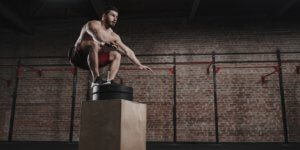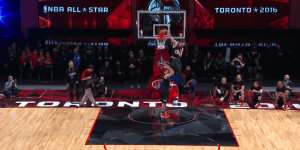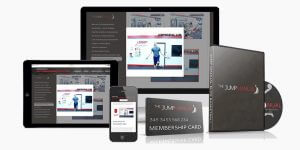You are just touching the bottom of the net, barely dunking a tennis ball, or already throwing down tomahawk dunks? No matter where you're at right now, every basketball player wants to jump higher!
The good news: there are some easy ways you can increase your vertical jump and in this article I'm going to spill the beans!

1. Strength Training
While you don't have to be able to squat 500lbs or deadlift 3 times your bodyweight, a certain amount of strength is required if you want to jump high. The vertical jump is all about firing your muscles very explosively, but if your lower body is very weak, there's only so much you can do.
Below are some strength exercises that will increase your vertical jump:
Bodyweight Exercises for Stability
A strong core is very important for the vertical jump because it provides the necessary stability for optimal transmission of force from the lower body to the upper body. If your core is too weak you will leak force during the takeoff which will make you lose valuable inches. A weak core is also often responsible for lower back pain or bad posture. The following exercises will help you to strengthen your core:
Hip Thrusts:
This is a great exercise for a muscle group that is underdeveloped in a lot of athletes - the glutes. Place your upper back against a bench or couch, bring your feet back so that the knee forms a 90-degree angle. Then start to push your hip upwards as far as you can until you are hyperextending your hips. During this movement make sure to consciously squeeze your glutes and hold the movement at the top for at least 2 seconds.
Supermans:
This exercise focuses on lower back strength and is a great substitute if you don't have access to a reverse hyperextension machine. Lay flat on the floor and make sure that your arms and legs are fully extended. Now raise your arms and legs about 4-5 inches from the ground, and focus on contracting your lower back muscles. Try to hold this position for 4-5 seconds, lower your arms and legs and repeat the movement.
Planks:
The various forms of planks are exercises that do a great job of strengthening your front and side abs. The goal is to keep your body as straight as possible while supporting your weight with the elbows and toes. Try to hold this position for as long as possible. Once you are strong enough to make it through 60 seconds you can place weights on your back to increase the difficulty.
Bodyweight Exercises for Lower Body Strength
The muscle groups responsible for most of the force generated during a vertical jump are the quads and glutes. Therefore most of the strength exercises focus on these two muscle groups. Other muscle groups like the calves, spinal erectors or arms have supporting roles, but they usually get strong enough in jump-specific exercises and don't necessarily need isolated workouts.
The following bodyweight exercises are great for athletes who are at the beginning of their vertical jump training and don't have access to a gym or weightlifting coach. But make no mistake, pistol squats are NOT easy!
Bulgarian Split Squats
Bulgarian Split Squats mainly work out your quads, glutes and inner thigh. Start standing with your front foot flat on the ground and your back foot elevated on a bench. Now lower yourself slowly into a deep squat position while making sure that the knee of your front leg doesn't move in front of your toes. Use the back leg for balance, but don't put too much weight on it. You can shift the stress from your quads to the glutes by moving the front foot further away from the bench.
Single Leg Deadlift
The single leg deadlift is a great exercise for your complete posterior chain that not only works on your strength but also improves your balance and flexibility. Plant your foot firmly on the ground and hinge your hips back while keeping the back leg completely straight. Make sure that you do not round your back during the exercise and try to keep the bend in your knees to a minimum.
Pistol Squats
The pistol squat is clearly the king of bodyweight leg exercises. It takes quite a bit of strength, balance, and flexibility to make a clean pistol squat, so don't hesitate to practice with assisted forms of this movement. If you fall on your back as soon as you bend too deep, you probably are missing ankle mobility. Try this ankle stretch to improve range of motion in the ankle.
Heavy Weightlifting Exercises For Maximum Strength
These exercises increase the maximum force that your body is able to generate. They are a nice complement to every vertical jump training program as long as you also learn how to use this strength in an explosive way through plyometrics or quicker weightlifting exercises. Athletes will often focus on building up their maximum strength during the offseason and turn towards more explosive and sports-specific exercises as the start of the season approaches.
The most popular vertical jump training program featuring heavy weightlifting is the Jump Manual:
The following exercises can lead to bad injuries if performed incorrectly, so please make sure to get a coach that can show you how to perform them in the right way:
Squats
There is a myriad of different squat varieties: Box Squats, Full Squats, 1/2 Squats, 1/4 Squats, Back Squats, Front Squats and I am sure a dozen more. Some varieties put more focus on the quads, others put more stress on the glutes, choose the version that best suits your capabilities. Make sure to pay attention to good form as injuries during the squat can be devastating. If you have trouble keeping your back straight at the bottom, try front squats or reduce the range of motion.
Deadlifts
Dead Lifts are working out nearly all the muscles used in a vertical jump and they do an especially great job in working on your hip extension, activating the hamstrings and spinal erectors. In the attached video you can see a trap bar deadlift which is easier for most athletes because it is a more natural position. If you have problems keeping a neutral spine when lifting the barbell from the ground, try to lift the weight from a slightly elevated position. You can also try sumo deadlifts where your lower your body through a wider stance of your legs.
Weighted Explosive Exercises
Weighted explosive exercises like Olympic weightlifting are a great way to bridge the gap between slow strength exercises and the explosive and powerful movements of a vertical jump. They do a great job of teaching the body how to create a lot of force in a very short time period and translate well because of very similar movement patterns.
These exercises generate very high forces and should only be performed if you already have a sufficiently strong core. Also, make sure to have an experienced coach that can teach you proper form. If you perform these exercises correctly you will teach your body to use your strength more explosively.
Jump Squats
This exercise is great for vertical jump training because it teaches your body how to produce very high power outputs during the actual jumping motion. You want to focus on quickness in this exercise, therefore use only very light weights. A common mistake is to use heavy weights, therefore losing speed and putting a lot of pressure on your joints. If you don't have access to dumbells you can do this exercise while holding a medicine ball in front of you or while wearing a weight-west.
Hang Clean
The hang clean is a simplified version of an Olympic lift and focuses on an explosive extension of the hips. Its technique is not as complicated as other Olympic weightlifting exercises, but it still makes sense to have a coach look at your execution in the beginning. Isolated hang clean workouts have shown to increase the vertical jump more than isolated squat workouts which is probably due to it's quicker and more powerful execution compared to slower squats.
Backward Medicine Ball Throws:
This exercise works very similarly to the hang cleans but is much easier to learn. Hold the ball between your legs, squat down and explosively throw the ball behind you. During the throw, make sure to extend ankles, knees, and hips, you can even add a little jump in the end. This exercise not only works on lower body explosiveness but also trains the upper body to do a full and strong arms swing which is important because the arm swing accounts for as much as 20% of your vertical!
2. Plyometric Training
Plyometric training has become immensely popular in recent years and today the term is often used synonymously with vertical jump training.
The purpose of plyometric training is described as follows:
If you want to improve your vertical you need to be able to activate your strength within a very short time frame - and plyometrics are the perfect way to learn this skill!
The most well known vertical jump training program that relies heavily on plyometric exercises to achieve goal astonishingly quickly is Vert Shock:
Popular Plyometric Exercises for Basketball Players
In the following paragraphs, I will present five plyometric exercises ranging from low-intensity plyometric exercises suitable for beginners to more advanced movements that require a decent level of strength and coordination. These exercises will have a big impact on your vertical and make you jump a lot higher in just a few weeks of training!
Two-Foot Ankle Hops:
Stand with your feet shoulder wide apart and hop continuously only using your ankles. Make sure that you don't bend your knees and that you extend your ankles to the full range of motion during each jump. Also, try to limit the ground contact time to the absolute minimum. This is a great exercise to develop quickness in your feet.
Slalom Jumps:
This exercise is also often called "line jumps" because you draw a line on the ground and try to hop from one side to the other as fast as possible. Keep your core stable and look for very quick ground contacts, jump height is NOT important in this exercise. Every hop counts as a repetition and you can do this exercise staying in the same spot or moving slightly forward as shown in the video.
Power Skipping:
Power Skipping is a great exercise training the explosiveness off of one leg. The goal is to jump as high as possible of alternating legs while keeping a slow jog forward. While doing the exercise focus on driving the knee of the off-leg as far to the chest as possible. This exaggerated movement will improve the power of your leg swing and your one-leg vertical.
Rim Jumps:
Place yourself under a basketball rim an try to tap the rim with your hands. After landing, immediately bounce back up and try to touch the rim again. If you can't reach the rim you can use the backboard or do the drill in front of a wall trying to reach the highest point possible. Focus on minimal time spent on the ground, stop as soon as the jumps get significantly lower.
Drop and Freeze:
Step off a box that is around 18-24 inches high. Make sure to land on both feet simultaneously with your knees bent and try to stop any momentum immediately. This is a great exercise for weaker athletes that are not yet used to high-impact plyometric exercises. It prepares the body to better coordinate the high forces during landing and prepares them for real depth jumps.
Single-Leg Depth Jumps:
Single leg jumps should only be done by experienced athletes and the height of the box should be chosen carefully. The athlete drops off the box like in a regular depth jump, but lands on only one foot. After the landing, the athlete tries to explode back up as quickly as possible. Make sure that your knee doesn't buckle and that the center of gravity remains over the jumping leg. As an added difficulty, add a box to jump onto.
3. Improve Your Vertical Jump Technique
Vertical jump training should always include a large amount of performing your preferred leaping style to teach the central nervous system how to perform this movement in the most efficient way possible. Early improvements in vertical jump height will almost always come from an improved vertical jump technique and less from improved strength or power.
In a lot of athletic movements, there is only one technique that is considered to be optimal. Vertical jump technique, however, is different! The most obvious difference is that some athletes prefer to jump off one foot while others like to take of off two feet. There is no definitive answer to which style of jumping will lead to a higher vertical, athletes will usually automatically pick the style of jumping that suits their physique best. But there are some general guidelines on which athletes will perform best using each technique:
One-foot vertical jump technique
In general, one-foot jumping is preferred by lean and lanky athletes who are very quick but not very muscular (think Zach LaVine). This style is defined by very short ground contact times, little bend in the knees and explosive movement of the glutes and hips. The technique takes a fair amount of coordination, and proper training instructions can bring a lot of improvement even for natural two-foot jumpers. For a detailed explanation of one-foot jump technique read more here.
Two-foot vertical jump technique
Two-foot jumping is often preferred by strong athletes with a build similar to football players. This style is defined by longer ground contact times and much deeper bending of the knee. Because of this, two-foot jumping favors strong athletes that can produce a lot of force in their quads.
Athletes that are not blessed with insane quickness and stiff Achilles tendons needed for high 1-foot jumping, can still reach impressive vertical jump height using the slower 2-foot jump technique. Find out more about how to perform 2-foot jumps correctly here.
4. Better Warm-Up & Stretching
Vertical Jumping is a very dynamic movement that puts a lot of stress on your muscles, tendons, and joints. It is therefore very important to be properly warmed-up before starting to perform high-intensity training. This warm-up will not only improve your performance but also reduce the risk of injuries significantly.
Warm-up
Make sure that you start with a general warm-up that gets your blood flowing and elevates your heart-rate. You could just dribble the ball around the court, drive on a bike or run on a treadmill. The ideal warm-up exercise for vertical jump training is probably the Skipping Rope - it works out your whole body, especially the muscles relevant for the vertical jump. Get yourself a great jump rope with 90-degree ball bearing aluminum handles like this one, and general warm-up is a lot of fun all of the sudden!
After the 5-10 minutes of general warm-up, you want to move to the specific warm-up. The role of this part of the warm-up is to activate the central nervous system and prepare the body for the specific movements which are to come. For jump training, good specific warm-up exercises would be tuck jumps or power skipping. Before a lower body strength training workout, squat jumps or box squats are great preparation.
Stretching
The role of stretching is a bit contradictory. You want to have a decent level of flexibility and range of motion to ensure fluid motion and prevent injuries. But scientific research has also shown that long static stretching before a plyometric workout can actually hurt your results because you lose elasticity in your muscles and stability in your joints.
Therefore, you should focus on dynamic stretching before your workouts. Dynamic stretching focuses on using momentum to putting your body through the whole range of motion of upcoming exercises. Examples of such exercises are forward lunges, backward lunges, knee to chests, toe touches, lateral leg swings, straight leg swings, hip rockers and much more. Check the Youtube Video for an example of a dynamic stretching warm-up.
5. Get Enough Rest & Proper Nutrition
If you follow a good training protocol then there are two main factors that could slow down your gains: Not enough rest for your body to regenerate from the demanding workouts, and not enough fuel for your body to build up new muscle tissue.
Rest
Often times athletes tend to begin a new training regimen highly motivated and so they want to train all day, every day. Unfortunately, this comes with two problems:
- The huge amount of workouts leads to overtraining and actually hurts your vertical jump
- The new workout schedule is not sustainable and athletes quit after a few weeks.
Starting with 3 relatively short workouts per week will give your body enough rest between workouts, and is much more sustainable in the long run. Intense plyometric training is especially taxing on the central nervous system and should never be done more than 2-3 times a week. Also, make sure to get enough good sleep because most of the body's adaption to the new training happens during bedtime.
Nutrition
Your body reacts to the physical stress of workouts by building new muscle tissue as well as stronger tendons and ligaments. But to do so, the body needs a lot of fuel. The main building block of new muscle tissue is protein, so make sure to eat enough of it!
A popular recommendation for athletes is to eat at least 1 gram of protein per pound of bodyweight. This can be achieved by eating a lot of lean meat, fish, nuts, eggs, beans, lentils or other seeds. If you have trouble getting enough protein through your regular diet, it makes sense to add protein shakes. Whey protein shakes are a very quick source of protein and drinking them right after the workout can give your recovery process an additional boost for optimal results. If you cover the large part of your protein intake through natural food, then a 5-pound bottle of good whey protein (like this) is a very good supplement and can last you for quite a while!
6. Get Better Shoes
Nothing kills a good vertical jump quite like an old pair of slippery basketball shoes. If you want to maximize your hangtime make sure that you have basketball shoes that are up to the task:
Get Basketball Shoes with top-notch traction
During a vertical jump athletes convert the speed of the the approach into a powerful takeoff. But this only works if you can plant your feet firmly and with confidence. Shoes that bite the floor can increase your vertical jump by a few inches easily.
Check out this article to find basketball shoes with the best traction.
Get Basketball Shoes with firm and stable cushioning
Basketball shoes with soft and mushy cushioning like the Lebron series can hurt your vertical jump height as you put to much of your force into the cushioning instead of into the ground.
High jumpers for example, wear super stiff waffles that allow an optimal and unhindered energy transfer.
You can find shoes that offer a great balance of cushioning and traction that is ideal for vertical jumping here.
Conclusion
Hopefully that's all you need to get started on your journey to rim-shattering dunks. If you're ready to start check out my free vertical jump program which will help beginners and intermediates to increase their vertical jump with an easy-to-follow 10-week program.


Founder of thehoopsgeek.com. A passionate basketball enthusiast and coding geek, Andy combines a love for sports with technology.












Hi, would it be possible substituting the sprints with something else to perform the entire program in house?
The idea behind the sprints is to have an exercise with very short ground contact times to increase your “bounce”. You could substitute it with ankle hops and focus on a very short ground contact time.
How many inches i can get from this workout?
Hey Berwyn. That’s really hard to tell because it depends on so many factors like how high your vertical already is, how athletic you are in general, your body composition, age, workout discipline etc. If you are completely untrained you could gain 10 inches or more, if you already have a 45 inches vertical you will probably gain very little
How much should the medicine ball weigh for these exercises?
This really depends on how strong you are. It should be heavy enough to be challenging, but light enough so that you can still do the exercise explosively. I built my own medicine ball by filling an old basketball with sand. I think it ended up weighing around 20lbs which was pretty heavy.
hey coach andy im 5’8 and my running vert 35 inch and my stand vert 33 how many inch if your program end ty
Very difficult to tell as your vertical is already great, but 40 inches should be possible!
I would recommend to do explosive exercises for example 3-4 sets, 4-5reps, 90sec – 2min rest between sets. Thats way more better to increase your vertical jumps.
Reason for this is simple.. example: if you want to run 100meters fast you do not run marathon right?
If you wanna increase your vertical jump height you wanna increase your explosiveness and speed. If you do 20jumps in one set you will increase your endurance not explosiveness. Thats my opinion 🙂
Good exercises for that:
Seated box jump 3-4sets, 4-6reps
Hurdle jump 3-4sets, 4obstacles + little sprint
Medicine ball broad jump 3-4sets, 6jumps
Depth jump 4sets, 4-5reps
Kneeling jump 4sets, 4-5reps
(after kneeling jump you can also add jump to the up, forward or one leg side jump, or you can just do kneeling jump without enything else)
Max height jump 4sets 4-5reps(variation examples: vertical jump, 1step, 3step)
Hi, 2×20 means i have to do 20 reps for 2 sets right ??
That’s right!
Could I do the workout for 2 times a week because my workout split is Lower/Upper/Lower/Upper
I don’t think I completely understand your question. How exactly would you try to split the workouts?
After doing this program what should I do to maintain my vertical and continue increasing it
Take a week off to get some rest and then you can just do it again!
After doing your workout for 2 weeks, I can’t touch the rim anymore. I used to be able to easily touch it. What am I doing wrong?
This is very common for a training program like this. Your body is tired from the workouts and needs time to recover to get back to 100%. If you want, you can take a few days off from the training and check your vertical again – I am sure it’s going to be better than 2 weeks ago!
Is it ok if I do the workouts 6 times a week and take a one day rest on Sunday? Would that be too less recovery time?
Hey Justin, stick to the 3 times a week. Recovery is a very important part of every workout and 6 times a week is really not sustainable
How long I should rest between reps and workouts?
Do 3 workouts a week and keep rest between repetitions long enough to be almost 100% rested again.
Do 3 workouts a week and keep rest between repetitions long enough to be almost 100% rested again, especially for the explosive exercises like depth jumps.
I lack something more. Sometimes i can grab the rim but more of the time i can not even touch the rim. I know i have enough strength all the time to grab the rim but i am not able to put that strength into jumping. I dont know whats the matter. Or i think i only do strength training and lack polymatrics or something else.
Is it okay to add weight to the things in the program like hip thrusts and the split squat?
It’s okay to add weights to these slower exercises, just don’t add weights to jumps or explosive movements.
Hey I always make the workouts in the park so I dont have access to a medicine ball. Is there a alternative to the excercises where I need one?
Hi Johannes, you can just do the medicine ball twist without using a medicine ball. The backward medicine ball throw is difficult to replace, maybe try deep squat jumps where you really focus on hip extension.
How much inches I get if my vertical jump is 28 inches and height 5’8 after doing this workout and can I do this workout 2 workout each day
Honestly, it’s impossible to tell exactly by how much you could improve your vertical. 28 inches is already pretty good, but I am sure that you could improve that by 5 or more inches within 10 weeks. What I can definitely tell you: 2 workouts a day is way too much and will only lead to overtraining and injuries.
Hey Andy! I’m 5 feet 10 and don’t have athletic genes. I haven’t done any Strength training or vertical jump training in my life. I’m fat a little bit (not so much) and not so strong. What would be my results from this training? Do you have any tips to give me?
Honestly, it’s impossible to know how well you will respond to the workout as it depends on so many factors. Just go for it, and let me know how it goes!
Can you do this program in addition to doing your normal leg workout two days a week with squats and deadlifts
Maybe you need to spread out the workouts a little more to avoid overtraining, but it should be doable!
I don’t have any of the equipment for phase 2 what should I do?
Try to replace the exercises as best as you can with similar exercises. What exactly are you missing?
How many inches are typically gained after 5 weeks?
That’s really hard to say because it depends on so many things like your current vertical jump, your fitness, and genetics. Just try it and let us know how it went for you!
And also when it says yards, I’m not sure how much that is so is there an amount of reps instead?
A rough estimate: 1 yard = 1 step.
Heyyyyyyy coach, I love your program so so much!!
I finished first 2 weeks and my vertical increases 2 inches and my current vertical jump is just 25.5 inches and height 5’8; after completing this full training , how many inches i can reach
Thanks!!
Thanks, that’s a great start! I’d say you should be able to at least reach 30 inches, maybe more! Let me know how it goes!
hey coach!!
I am in the first workout of week 3 !
But after doing week , I can’t see any improvement :((
Also , my leg didn’t feel any pain and tỉe like last week after each workout …
What should I do coach ?
Keep going! Week 4 introduces new exercises which should be more “painful” again 😉
my legs feel great back ! yay!
I’m in the last workout in week 3
I have a question ? Is this okay if I use a 3 kg ball for next period’s workouts ? ( Medicine Ball Twists )
And how can I do Backward Medicine Ball Throws in my house ?
thanks!! <3
A heavier ball would be better, but a 3kg ball will do. The throws will probably not work in-house, is there nowhere outdoors closeby where you can do them?
are there any other exercises for that ?
hmmm it would be very difficult for me ..
Are there any other execises ?
Hey my name is Mukhlis. I’ve been feeling pains in my knee for the past year now but then I want to increase my vertical.
Better check out a doctor and find out what’s causing this pain in the knees. Vertical Jump training can be quite taxing on the knees, you really don’t want to make it even worse.
Hey Coach I’m 6’1 I played basketball in high school and without training I used to be able to do simple dunk 1 and 2 hands but jumping 1 leg . but when I went to college I stopped training and I put on some weight I can barely touch the rim . I went from 70 KG to 85 KG . I wonder if it wouldnt be better to lose some weight before starting the program. Also I want to start training with a team 3 teams a week will it be appropriate while training?
You could start by losing some weight, do some basic strength training to get your body prepared for the vertical jump training. But in general, you can also work on your vertical with your current weight, it will just be more stressing for your joints and tendons.
Hey Andy, i’ll start the program on monday.
I am already able to dunk but its not consistent and I want to become better. I am 5’11 and my vert is around 35 inch. Do you think I am able to increase?
35 inches is already a pretty amazing vertical – great job! I am sure that you can still further improve, but don’t expect crazy gains at your level.
I don’t feel pain in my legs after 1st week workouts. Can vertical jump be improved owithout feeling pain?
I am now on week 5 and I still see no improvement in my vertical… any tips?
Hey Cam. Sometimes it just takes a while for the body to adapt to the workout. Taking a break for a few days can help your body to get back to 100% to really see the effects of the training.
Also, how high was your vertical before the workouts? Did you accurately measure it?
I touched 10 feet and I’m about 6’1
You can take a few days off and check your vertical to see if your body is just a little bit tired right now. At your current level, there should still be plenty of room for improvements.
I currently have a 16 inch vertical and I am 5’8. If I do this workout how many inches will I gain?
Hey Jeff, I get asked this all the time and I don’t have a great answer. It depends on so many factors… But your current vertical is pretty low, so there is a lot of room for improvement!
Hey Andy,
I’m 14, 6’1″ with a current 25 inch vertical. I plan to start the program tomorrow, but already have a strength program that includes two leg workouts a week. Can I do these both at the same time, and, if so, how should I plan my weekly workout schedule to accommodate for both?
I would just try if you can tolerate the workload of both programs. If it’s too much just spread it out a little more and do one less workout per week. Also, I would try to time the workouts so that you don’t have to do a vertical jump workout right after a strength workout.
Ok, I’ll give it a try. Thanks!
Can I substitute jogging for my warmup? and can i do a few sets of pushups and situps as well before i start the exercises?
Sure!
Hey Andy, how long approximately should a days work out take?
Probably around an hour
I’m looking at this workout for my daughter who’s a volleyball player. After reading through everything it feels as this is geared towards male athletes, would you recommend this workout for girls?
Thanks for the comment. I can’t think of a reason why this shouldn’t work for girls too! Probably should mention this in the article.
I am actually a girl volleyball player and I am on the last week of the program. I have noticed that I am more quick and a little more explosive. I haven’t really had time to take a break to test my vertical but the program definitely makes you quicker.
Hi Chelsea, that’s great to hear!
Is it okay to play basketball and lift weights on off days and training days?
Just listen to your body. If you are sore and hurting you should take a few days off. If you feel fine then go for it!
How come after certain days, my vertical disappears? The most I’v gone with touching rim is 5 days, and then I couldn’t touch it. My apologies if this has been typed to death.
That’s a sign that your body needs a little rest to get back to peak performance. If you train too much your vertical will decrease for a few days due to fatigue, once you rest up you will come back stronger and jump higher than before!
UPDATE: I think I can touch a 10 foot rim, now. However, I can’t grab it or put my hand over it. If by any chance I pass the 10 weeks and I don’t end up dunking, should I repeat this program again from the very beginning? If not, what do you recommend I do?
Does this program work for kids 13 and under? Can it be bad for them?
Kids under 13 should be fine! This program is directed towards beginner/intermediate athletes and the exercises are all suitable for kids of all ages.
Hey Andy, is this program mostly the same as Vert Shock?
No, this is completely different.
Hey Andy, I’m 6’4 and rim grazing right now… my vertical I think is barely 15″ … do you think your program an help me gain 5 more inches if done right???
For sure!
I do have Access to a gym and have fun doing squat and deadlift once a week. Should i stop doing that when i do the Programm or can I do both?
You can do both, just make sure you take breaks when it gets too much.
Hey Andy I’m 15 and 6’. I was wondering if I can get to a 30” vertical off this program if it is already 23”
Hey Kyan, I can’t guarantee it as every athlete reacts differently to workouts, but there’s definitely a good chance!
Try it out and let me know how it goes!
Hey Andy! I have a couple of questions. First of all, do you think this program will help for a soccer goalkeeper?
I have not read through the program very carefully yet, but if I need special equipment for any of these exercises, do you have any exercises I can do instead?
I am 18 years old, and my weight is about 60 kilos. I am 177 cm tall, and when I jump, with my arms, but no runup, my head reaches about 50 cm higher, at the most (which i guess means that my vertical jump is 50 cm?). How many cm will I realistically reach?
Hey Ingar, i don’t see a reason why it wouldn’t work for a goalkeeper! The program will not only imcrease your vertical, but also make you more explosive in general which should be really helpful and improve the speed of your reactions. I personally made it to around 92cm, but 70 cm should be totally doable!
Hi Andy!
Is’nt 30-40 inches vertical jump at the same level as pro athletes (the best basketball player for example)? Is it really likely that I will reach the same level as them in 10, or maybe 20 or 30 weaks, with this program? My vertical jump is just under 20 inches now
Going from 20 inches to 30 inches should be possible for almost any athlete that dedicates a lot of time to vertical jump training. Going from 30-40 is a bit tougher and takes some talent, but I know recreational basketball players that have a vertical jump >40 inches!
i have already done the program when i do it again do i start at week 7 – 10?
Yeah, I’d start in week 7. I’d be interested, how it went the first time?
right now my vertical is 18 or 20 inches. what should my vert be after this program
Tough to say as it depends on so many things. Just try it and let us know how it went!
Hey!
I will try this program.
My question is: Is it possible to combine this workout 3 days a week with my 2 days a week basketball sessions?
or is it to much stress to my legs?
That should be no problem. But if you notice that your body is getting very tired you can spread out the workouts more and only do 2 workouts a week for example
Hey!
After I finished the third week, I accidentally hurt my toe the third, and last, day of rest. Now, after a 2-3 weeks break, I am ready to go back to the training. Do you think the break will be damaging for the progression or something, meaning I should start from scratch again at week 1? Or should I keep going into the fourth week, like nothing happened?
I’d continue with week 4!
Hey i got a few questions and am hoping you could help me with it.
I am about to start the program and my height is 5’0 to 5’1(yes i know i am small) and i’m 15 with about 47kg and my standing vertical jump is about 55cm or 21 inches(i dunno when i did the test i was quite lazy and didn’t jump my all but that’s probably the average i guess(i am a volleyball player)
Like would it help me if i wore 2kg of weights? Or is it even effective for me?
Can i reach 30 inches of vert if ever?any recommendations for me to have more gains?
Cause i plan to reach 40 inches vertical by the end of the year
At around a 20″ vertical there should be a lot of room for improvement without wearing additional weights. Additional weights increase the risk of injuries and should be reserved for well-trained athletes. With dedicated training, a 30″ vertical should absolutely be possible, but 40″ takes a LOT of work and also talent. I’m not saying it’s not possible but I wouldn’t plan on it.
What can i substitute with the deadlifts exercise and medicine ball exercise ? How much do you think I can gain from this. I have 24 inches running vertical and im 16.
Hi Yousef, if it’s somehow possible stay with the exercises in the program. If you can’t: you could replace the medicine ball throws with deep squat jumps where you really focus on hip extension and the single-leg deadlift with superman planks. I try not to make predictions about possible gains as it depends on so many things…
Hi Andy, does this program work for a trained person? It seems very light to me.
Hi Victor. Depends on what you define as a trained person. The aim of the program is to build a strength base and work on your explosiveness and “bouncieness”. So if you are doing heavy squats in the gym, the strength part will not do much for you, but the explosive exercises will still improve your vertical jump a lot because they will teach your body how to use all your strength in a matter of milliseconds.
Hey Andy
Im 14years old my height is 6’3” and my vertical is 29 what’s my vertical after the Programm and is it bad when I do the exercises after my volleyball training
29 inches is pretty good already! But I am sure there is room for at least another 5 inches in the 10 weeks of the program. However, it’s really difficult to predict the results as it depends on so many things…
Explosive jumping exercises are mose effective if you are doing them with 100% intensity which may be hard after volleyball training. I think it would make more sense to do the workout before practice.
Okay Thank you andy and 1 another question ich have volleyball training Monday Tuesday Thursday I Do the program now wensday Friday and Sunday is that ok
Good morning! Is it possible to determine on average how much my vertical impulsion can improve with this training? I’m 35 years old, 1.85m, 77Kg and I’ve been playing basketball for some time. And after ten weeks of training is over, how long after that can I repeat the training to increase the vertical thrust even more? Would you suggest any supplements to maximize vertical impulsion gains? Thank you!
Yours sincerely,
Alexandre A. dos Santos
The results depend on so many things, I try to not guess what te workout can do for you. It especially depends on how good your vertical jump already is. The worse it is right now, the bigger the room for improvement.
After ten weeks I would take at least a week off.
Hey coach, is it ok if i leave some exercises out? I have some lower back pain issues and i don’t want to
Sure! You should always listen to your body, otherwise, you are just begging for more severe injuries.
Hey
I have finished week 7, waited almost one week, and I measured my standing vertical. The result was apporximently 20 inches, the same as after week 3, and actually the same as before I started with this program. I measured a couple of days ago too, and got the same height, so I don’t think the bad result is due to a bad day or something. Does this mean this program does’t work for me or something, because I have no idea what I did wrong and I am kinda losing my motivation to continue.
Hi Peter! How are you feeling right now? Are you tired and heavy-legged? If that’s the case it might make sense to take a few days off to rest and give your body a chance to regain 100% strength and explosiveness. I often see that people experience the biggest gains a week after they finish the workout!
I don’t feel tired. I have taken a week and a half off now, but still no progression.
Do you think that means this program does not work for me or do you think it is something else? I really don’t know what I might have done wrong.
After just 8 weeks of this workout I was able to throw down my first dunk! Btw I am 6 foot. Real great workout if you are a beginner and want to dunk in just 2 months. Just wondering if my vertical will decrease faster after finishing the workout.
My results after 8 weeks is a gain 5 inches from 29 to 34 great program thank you!!!
Good afternoon! I don’t think I understood correctly, how to do three exercises if in weeks 8-10, for example there are 06 exercises and in weeks 4-7 there are 07 exercises? Thanks!
Hi – I have two questions…
1) I am surprised there are no box jumps (either 2 leg box, or 1 leg lateral box), just curious why. Is there any downside to box jumps?
2) Do you always complete all sets for one exercise before moving onto the next exercise? (vs. going through one set of each exercise and circling back for through for second set)
1) By box jumps you mean jumps where you jump onto a box (different from depth jumps where you jump off a box)? If so, the only advantage would be that you have a softer landing on the box and protect your joints a little better. Other than that, it’s really just a simple jump!
2) I always finish all sets of one exercise before moving on to the next one.